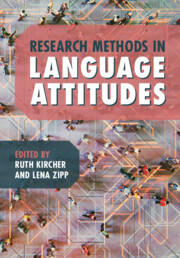17 results
Foreword
-
- Book:
- Research Methods in Language Attitudes
- Published online:
- 25 June 2022
- Print publication:
- 07 July 2022, pp xiii-xviii
-
- Chapter
- Export citation
Figures
-
- Book:
- Research Methods in Language Attitudes
- Published online:
- 25 June 2022
- Print publication:
- 07 July 2022, pp viii-ix
-
- Chapter
- Export citation
Index
-
- Book:
- Research Methods in Language Attitudes
- Published online:
- 25 June 2022
- Print publication:
- 07 July 2022, pp 405-410
-
- Chapter
- Export citation
Tables
-
- Book:
- Research Methods in Language Attitudes
- Published online:
- 25 June 2022
- Print publication:
- 07 July 2022, pp x-x
-
- Chapter
- Export citation
Acknowledgements
-
- Book:
- Research Methods in Language Attitudes
- Published online:
- 25 June 2022
- Print publication:
- 07 July 2022, pp xix-xx
-
- Chapter
- Export citation
References
-
- Book:
- Research Methods in Language Attitudes
- Published online:
- 25 June 2022
- Print publication:
- 07 July 2022, pp 346-404
-
- Chapter
- Export citation
Part 3 - Indirect Methods of Attitude Elicitation
-
- Book:
- Research Methods in Language Attitudes
- Published online:
- 25 June 2022
- Print publication:
- 07 July 2022, pp 183-268
-
- Chapter
- Export citation
Part 2 - Direct Methods of Attitude Elicitation
-
- Book:
- Research Methods in Language Attitudes
- Published online:
- 25 June 2022
- Print publication:
- 07 July 2022, pp 97-182
-
- Chapter
- Export citation
1 - An Introduction to Language Attitudes Research
-
-
- Book:
- Research Methods in Language Attitudes
- Published online:
- 25 June 2022
- Print publication:
- 07 July 2022, pp 1-16
-
- Chapter
- Export citation
Copyright page
-
- Book:
- Research Methods in Language Attitudes
- Published online:
- 25 June 2022
- Print publication:
- 07 July 2022, pp iv-iv
-
- Chapter
- Export citation
Contents
-
- Book:
- Research Methods in Language Attitudes
- Published online:
- 25 June 2022
- Print publication:
- 07 July 2022, pp v-vii
-
- Chapter
- Export citation
Contributors
-
- Book:
- Research Methods in Language Attitudes
- Published online:
- 25 June 2022
- Print publication:
- 07 July 2022, pp xi-xii
-
- Chapter
- Export citation
Part 1 - Analysis of the Societal Treatment of Language
-
- Book:
- Research Methods in Language Attitudes
- Published online:
- 25 June 2022
- Print publication:
- 07 July 2022, pp 17-96
-
- Chapter
- Export citation
10 - Questionnaires to Elicit Qualitative Data
- from Part 2 - Direct Methods of Attitude Elicitation
-
-
- Book:
- Research Methods in Language Attitudes
- Published online:
- 25 June 2022
- Print publication:
- 07 July 2022, pp 145-159
-
- Chapter
- Export citation
Part 4 - Overarching Issues in Language Attitudes Research
-
- Book:
- Research Methods in Language Attitudes
- Published online:
- 25 June 2022
- Print publication:
- 07 July 2022, pp 269-345
-
- Chapter
- Export citation

Research Methods in Language Attitudes
-
- Published online:
- 25 June 2022
- Print publication:
- 07 July 2022
6 - World Englishes, Migration, and Diaspora
- from Part I - The Making of Englishes
-
-
- Book:
- The Cambridge Handbook of World Englishes
- Published online:
- 16 December 2019
- Print publication:
- 02 January 2020, pp 120-142
-
- Chapter
- Export citation



